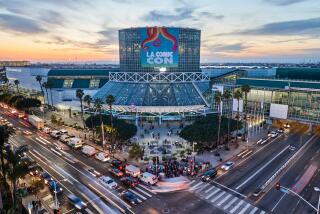A Century of Cars
- Share via
Ove
r a century’s time, the Los Angeles Auto Show has moved from Hamburger’s Department Store to the Pan-Pacific Auditorium to the Los Angeles Convention Center, with myriad stops in between. It’s grown from a local curiosity to an international sensation. And it’s come full circle — from prominently displaying electric runabouts to gas-guzzling muscle cars and now, finally, back to electric vehicles.
But amid all these changes, it’s perhaps been best at making memories.
The show leaves deep impressions on people, especially those who first glimpsed it as youngsters. For some, the show would lead to a lifetime love affair with cars. James Bell, executive market analyst for Irvine’s KBB.com, recalled being swept away as a teenager by the models — both automotive and human.
“I’ve been attending since I was 16,” said Bell, 42. “When I think back on the memories, it was the fantasy of it all, spending time with Lamborghinis and Ferraris. . . . Followed by the New York show, it had the greatest participation by exotic and fantasy brands. Those shows also had the most gorgeous models.”
For many, it was a father-son bonding ritual. Like untold others, editor Matt Stone of Motor Trend Classic in El Segundo first attended alongside his dad. “It was amazing to see all those new cars in one place at one time,” he said.
By the mid-1980s, it was Stone shepherding family members around the show. On one memorable occasion, he squired his British cousin Nigel to the extravaganza. Nigel gravitated to the Monte Carlo exhibit, probably because it was home to two statuesque models hired by Chevrolet. The models posed for a snapshot with Nigel and a Monte Carlo SS.
“That photo made Nigel the envy of all his mates back in England, hanging out with the new Chevrolets and these two beautiful American women,” Stone recalled.
Others remember the show from the perspective of parenthood. “Back in the 1980s, I took my kids and lost one of them,” said Finbarr O’Neill, president of J.D. Power and Associates. “There was about five minutes of panic.”
About the same time, O’Neill captured a mental snapshot of the kind many attendees carry for decades.
“I remember being in a new Saab and the cockpit was just great,” he said.“It was very much a reflection of Saab’s tradition of jet making — a very comfortable, ergonomically designed dashboard that gave you a sense of control and power.” It was all the more striking, he said, given that the era’s U.S. cars were saddled with squared-off dashboards and speedometers made with all the excitement of a slide rule.
This being L.A., the show has always been a favorite stomping ground for outsized personalities. In 1986 or ’87, Chrysler chief executive Lee Iacocca commandeered the spotlight, recalled Charlie Vogelheim, executive editor of Intellichoice.com. “Lee Iacocca came to town and took all the press away from the show in buses to a downtown hotel to show them Chrysler’s new luxury vehicle. The other carmakers were very upset by that. Lee was certainly an attraction in the day.”
Other personalities Vogelheim remembers include Isuzu’s hilariously smarmy fictional spokesman played by actor David Leisure: “Joe Isuzu would be there at the Isuzu booth; he’d be the one doing the intro,” Vogelheim added. “I think it was Mitsubishi introducing a new van, and they had Vanna White, Jerry Van Dyke and Dick Van Patten at the exhibit.”
It wasn’t that long ago that the Los Angeles show competed nearly head-on with Detroit‘s, which left the former at considerable disadvantage, recalled John O’Dell, senior editor at Santa Monica-based Edmunds.com.
“You basically got a second-class, ho-hum show,” he remembered. “That changed when they changed the timing [to November]. It’s now a major show, gets a lot more press coverage, particularly from Europe. You get better exhibits, better cars, and it’s now used to unveil cars and make news.”
Some exhibits are especially memorable. Such was the case in 2007 when Porsche Cars North America had showgoers eyeballing the 100-year-old Lohner-Porsche. Developed by Ferdinand Porsche and a smash at the 1900 Paris World‘s Fair, the Lohner Porsche was the world’s first running hybrid vehicle.
Each wheel hub had its own electric motor, allowing the car to travel to 31 mph on electric power before switching to gas, said Tony Fouladpour, spokesman for Porsche Cars North America, who was there to witness the crowd reaction to the car and the presence of California Governor Arnold Schwarzenegger. “It had huge crowd appeal. I think the governor spent 10 minutes there, speaking in German with one of our engineers.”
One of the hallmarks of the show has always been its connection to the city’s car obsession. Though elsewhere in the world Los Angeles is best known for the movie business, locally it’s a different story.
“It’s the true car culture,” Vogelheim said. “And in the end, it’s cars over stars.”
— Jeff Steele, Custom Publishing Writer






